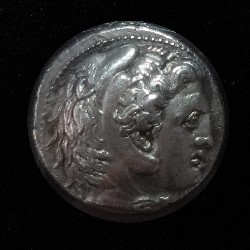
Tetradrachm
Alexander III {The Great}
mint of Susa
Gorny & Mosch, Auktion 257, lot# 306, 2018
---

Tetradrachm
Demetrius-II
mint of
Heritage Auctions 257, lot# 306, 2025
---
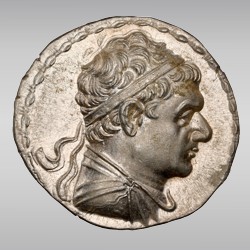
Tetradrachm
Heliocles
mint of
Heritage Auctions 257, lot# 310, 2025
Bactria
King Heliocles, the last King of Bactria, ca. 145 - 130 BC
diam 32 mm, wt 16.93 g. Apparently this was the Attic (heavy) silver standard.
Bactria is known for having the most realistic portraiture of their Kings. Also for being the furthest East of the Hellenistic Kingdoms. You have to see the example of Eukratides-I in the MOMA (Metro Museum of Art, NYC) for an example in extremely high relief. I photo'ed it & will try to post it here.

Paeonian Kingdom
King Patraus
ca. 335 - 315 BC
tetradrachm (light standard)
acquired ~ 1994
Laureate head of Apollo right / warrior on horseback right, spearing fallen enemy, M behind horse. Paeonia Hoard 198. SNG ANS -. SNG Oxford -
Rhodian standard, a reduced version of the Chian standard, was introduced by Rhodes around 300 BC and subsequently adopted throughout the Rhodian sphere in Caria and the central Aegean. It consisted of a tetradrachm of 13.4 g, didrachm of 6.7 g, and drachm of 3.4 g.[2][20]
Cistophoric standard was introduced by the Attalid dynasty of Pergamon around 190 BC and remained in use in western Asia Minor until the third century AD. The cistophorus itself was a tetradrachm of 12.6 g, divided into two didrachms of 6.3 g and four drachms of 3.15 g.[2]
both from Wikipedia
Tom Cederlind Auctions,
22 May, 2014, lot# 111
Ptolemy II r. 283 - 246 BC. While on-line charts seem to indicate this is Ptolemy III, I've been advised that the consensus of research indicates Ptolemy II. Also the size and weight of these is supposedly unusual at 98.1 grams. Ptolemaic bronzes at 67 grams and lighter are among the most common and inexpensive of large module ancient coins.
The circular pit in the coin center was used for machining purposes of the cast planchlets but
unlike the Aes Grave series, these were struck coins. There are several excellent sites devoted just to Ptolemaic bronzes:
http://www.megagem.com/ancient/ptolemy_series.html
http://www.ptolemybronze.com/
Unfortunately Tom Cederlind passed away. He was a very knowledgeable ancient coin dealer and unlike most,
he liked to talk to collectors about coins.
Ancient Egypt was conquered and incorporated into the Persian Empire. They rebelled against Persian rule in 404 BC, although ultimately had to wait for Alexander of Macedon before gaining some degree of independence. They became independent until conquered again by the Romans ~30 BC. These large bronze coins were struck while they were an independent nation.
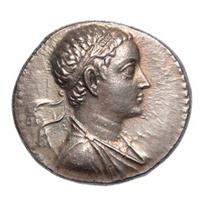
Egypt Ptolemy V, tetradrachm
Phoenician mint, 26mm, 13.99 g
Ed Waddell, Aug 2017
ex Numismatic Fine Arts (Beverly Hills),
Auction 16, NY, 1985, lot 292
historical comments
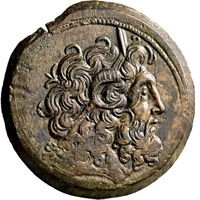
Egypt Ptolemy VIII,
AE 1/2 drachm
43mm, 38.63 g
Leu Numismatik, Auction #4,
May 2009, lot# 390
Ptolemy VIII Euergetes II (Physcon), second reign, 145 - 116 BC.
While described by Leu as in "exceptional condition", these are frequently encountered in this grade.
Bronze half-drachm, 43 mm, 38.63 g, 12 h. Now is my chance to see what "h" means!
Kyrene, obv: Diademed head of Zeus Ammon to right.
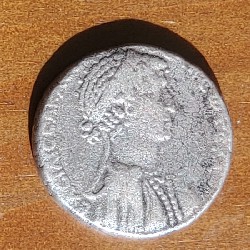
Egypt Cleopatra VII,
AR tetradrachm
--mm, --.-- g
Gorny & Mosch, Direct Sale, Jan 7th, 2023
Tetradrachm, Cleopatra VII Queen of Egypt obv,
& Marc Anthony, Roman Imperator rev.
Struck 36 BC, in Antioch, capital of the Roman Province of Syria, by the allied forces of Cleopatra & Marc Anthony.
Antioch became the 3rd largest city in the Roman Empire after Rome and Alexandria as well as an established mint.
Evidence points to its striking the coin although other sources don't pin it down to Antioch.
The defeat of Cleopatra & Marc Anthony in 31 BC at the naval battle of Actium and the subsequent defection of their military forces to Octavian, led to both their suicides in Alexandria in August, 30 BC. With Cleopatra's death this ended the Ptolomaic Rulers, the Hellenistic Era, the independent Kingdom of Egypt, and the Roman Civil War about the fall of the Roman Republic.
Detailed writeups on this coin are supplied here from 2 sources:
The Art Institute of Chicago
website
article in pdf
The New York Sale,
probably Goldberg's Auction
website
article in pdf